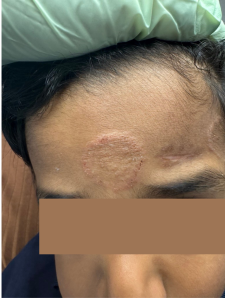

Testosterone supplementation has gained popularity not only among men but also among women seeking increased energy, muscle tone, and enhanced libido. However, what many patients don’t realize is that exogenous testosterone—especially when prescribed without proper medical oversight—can lead to a host of dermatological side effects.
In our dermatology clinic, we recently saw a female patient in her early 50s who presented with noticeable hair thinning and a receding frontal hairline. This pattern of hair loss is typically seen in men and is known as male-pattern baldness (androgenetic alopecia). However, it is increasingly seen in women undergoing testosterone supplementation, often prescribed by non-medical clinics or wellness spas without adequate hormonal monitoring.
This patient had been receiving testosterone supplementation at a wellness clinic to “boost energy and weight loss.” Unfortunately, she did not expect the potential for irreversible hair thinning and male-pattern hairline recession.
Testosterone is converted in the body to dihydrotestosterone (DHT) by the enzyme 5-alpha reductase. DHT is a highly potent androgen that binds to androgen receptors in hair follicles, especially those located at the frontal scalp and vertex, triggering miniaturization of hair follicles and leading to progressive hair thinning and recession.
Increased androgen levels also stimulate sebaceous glands, leading to higher sebum production and clogging of pores, which manifests as hormonal acne—often deep, painful, and cystic in nature, typically seen on the jawline, chin, chest, and back.
• 5-Alpha Reductase Activity: Elevated testosterone increases conversion to DHT, which directly affects hair follicle cycling and reduces anagen (growth) phase duration.
• Sebaceous Gland Stimulation: Androgen receptors on sebaceous glands lead to overactive oil production, promoting acne.
• Inflammatory Cytokines: Elevated androgens increase pro-inflammatory cytokines, worsening inflammatory acne lesions.
Unfortunately, androgen-induced hair loss, particularly with frontal hairline recession, is often irreversible without intervention. Treatments may include topical minoxidil, oral anti-androgens such as spironolactone or finasteride (in appropriate candidates), and procedural options like PRP (Platelet-Rich Plasma) therapy. However, prevention remains the best strategy.
• Hirsutism: Excessive facial and body hair growth, particularly distressing for women.
• Oily Skin and Persistent Acne: Often resistant to over-the-counter acne treatments.
• Skin Thickening and Coarsening of Features: Seen with long-term high androgen exposure.
• Increased Risk of Androgenic Alopecia: Accelerated in genetically predisposed individuals.
• Voice Deepening and Irreversible Vocal Cord Changes.
• Clitoromegaly in Women: Irreversible enlargement of the clitoris.
• Psychological Effects: Mood swings, aggression, and irritability have been linked to supraphysiologic testosterone levels.
• Increased Cardiovascular Risks: Studies have shown higher risks of thrombosis and cardiovascular events with unsupervised testosterone use.
Some former female bodybuilders and fitness influencers have spoken candidly on social media platforms about the long-term, often permanent, changes they experienced from anabolic steroid and testosterone use. These include facial hair growth, deepened voices, and permanent hairline recession.
In recent years, there has been a surge in non-medical “hormone optimization” clinics and spas offering testosterone pellets and injections without appropriate medical evaluation or monitoring. These establishments often lack board-certified physicians and fail to follow evidence-based guidelines for hormone replacement therapy.
According to a 2017 review in JAMA Internal Medicine, inappropriate testosterone prescriptions tripled over a decade, with many lacking documented indications or proper monitoring protocols (Baillargeon et al., 2017).
The Endocrine Society’s Clinical Practice Guidelines strictly advise that testosterone replacement should only be prescribed for documented medical conditions such as hypogonadism, confirmed by repeated lab testing, and under physician supervision.
Before starting any hormone therapy, it is crucial to consult with a qualified healthcare provider who can assess the risks and benefits based on clinical indications. If you’re already experiencing symptoms like hair thinning, acne, or unwanted hair growth, early dermatological intervention can help manage and possibly reverse some of these changes.
Disclaimer: These are actual patient stories from Dermatology Solutions, shared with written patient consent for educational purposes. Reproduction or distribution without written permission is strictly prohibited.